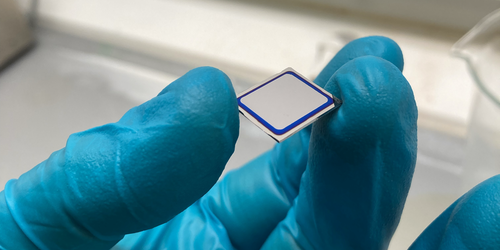Testing a New Solar Sandwich
Thanks to their reliability and cost, silicon-based devices have dominated the commercial solar-panel market for 50 years. But the sunlight–electricity conversion efficiencies of these devices are now nearing their theoretical limits. One challenging but promising way to increase this efficiency is to make solar cells from multiple materials with different photon-absorption properties, which would allow them to absorb more sunlight. Rasmus Nielsen of the Technical University of Denmark and his colleagues have done just that, demonstrating a solar cell that combines silicon with selenium, the first photovoltaic material to be discovered [1]. The researchers say that with updates, the performance of their selenium/silicon device could soon rival today’s best silicon cells.
In 1985, selenium topped the charts for the material with the highest photovoltaic efficiency. It maintained that place until around 2017, when silicon devices started outperforming those made from selenium. But selenium is receiving renewed interest. Selenium has a low melting point, making it less expensive to process than silicon, which must be heated to extremely high temperatures. The material also absorbs photons having a wider range of energies, which is attractive for next-generation solar cells.
To fabricate their selenium/silicon devices, Nielsen and his team crystallized selenium thin films on top of silicon solar cells that they had coated with various conductive oxide layers. Measurements using sunlight showed that these cells generate maximum voltages of 1.68 V and have power-conversion efficiencies of 2.7%. Although far from silicon’s maximum power-conversion efficiency of 26.8%, the voltage aligns with energy goals for multimaterial cells. The researchers say that the devices’ efficiency could be improved tenfold by reducing voltage losses from electrical resistance in the circuit and by increasing electron transport, which could be done by changing the conductive materials that connect the silicon with the selenium.
–Rachel Berkowitz
Rachel Berkowitz is a Corresponding Editor for Physics Magazine based in Vancouver, Canada.
References
- R. Nielsen et al., “Monolithic selenium/silicon tandem solar cells,” PRX Energy 3, 013013 (2024).




